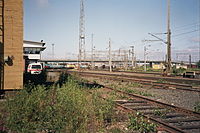
VR-Group Plc, commonly known as VR, is a government-owned railway company in Finland. VR's most important function is the operation of Finland's passenger rail services with 250 long-distance and 800 commuter rail services every day. With 7,500 employees and net sales of €1,251 million in 2017, VR is one of the most significant operators in the Finnish public transport market area.
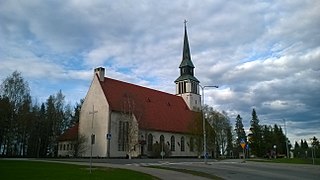
Kemijärvi is a town and municipality of Finland. It is located in the sub-region of Eastern Lapland.

An electro-diesel locomotive is a type of locomotive that can be powered either from an electricity supply or by using the onboard diesel engine. For the most part, these locomotives are built to serve regional, niche markets with a very specific purpose.

The Finnish railway network consists of a total track length of 9,216 km (5,727 mi). Railways in Finland are built with a broad 1,524 mm track gauge, of which 3,249 km (2,019 mi) is electrified. Passenger trains are operated by the state-owned enterprise VR that runs services on 7,225 km (4,489 mi) of track. These services cover all major cities and many rural areas, though the coverage is less than the coverage provided by the bus services. Most passenger train services originate or terminate at Helsinki Central railway station, and a large proportion of the passenger rail network radiates out of Helsinki. VR also operates freight services. Maintenance and construction of the railway network itself is the responsibility of the Finnish Rail Administration, which is a part of the Finnish Transport Agency. The network consists of six areal centres, that manage the use and maintenance of the routes in co-operation. Cargo yards and large stations may have their own signalling systems.

Pasila station is a railway station in Helsinki, Finland, approximately 3.5 kilometres (2.2 mi) north of Helsinki Central. It is the second busiest railway station in Finland, after Helsinki Central, and takes up a large part of the district of Pasila. The station was first opened in 1862 along the Finnish Main Line. The current station building opened in 2019.

The Glasgow–Edinburgh via Carstairs line is a main railway route which connects the Scottish cities of Glasgow and Edinburgh, by means of their respective sections of the West Coast Main Line (WCML).
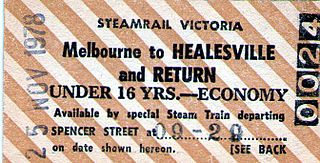
The Healesville railway line, in Melbourne, Australia, was the non-electrified continuation of the suburban Lilydale line, extending into the Yarra Valley. The line closed in the 1980s, but a heritage railway group, the Yarra Valley Railway, is working to retain part of the line between Yarra Glen and Healesville.

Tampere Central Station is a functionalist building in Tampere, Finland, designed by Eero Seppälä and Otto Flodin, completed in 1936. The station is one of the most important railway stations in Finland. In 2015, the Tampere Central Station was the second busiest railway station in Finland in terms of numbers of passengers, after the Helsinki Central Station.

The Kouvola railway station is located in the city of Kouvola in Finland.

Oy Karelian Trains Ltd was a joint venture agreed on 23 November 2006 between Russian Railways (RZhD) and VR Group to facilitate the operation of international express passenger rail services between Helsinki, Finland, and Saint Petersburg, Russia. Karelian Trains was registered in Helsinki; VR and RZhD both owned 50% of the shares. The services are branded as Allegro.
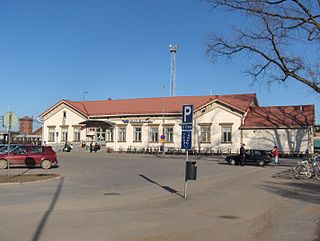
Joensuu railway station is located in Joensuu, North Karelia, Finland. The station was opened in 1894.

Kemijärvi railway station is a railway station located in Kemijärvi, Finland. It was opened in 1934 when the railway was extended from Rovaniemi to Kemijärvi. It is operated by the VR Group, and maintained by RHK, the Finnish Transport Agency.

Rovaniemi railway station is located in Rovaniemi, Finland. The line from the south opened in 1909, and was extended to Kemijärvi in 1934. It features direct daytime and overnight passenger trains to Oulu, Tampere, Helsinki and Turku; as of March 2014 the overnight train provided the only passenger service north to Kemijärvi.

The Sm3 Pendolino is a class of high-speed body-tilting trains operated by VR Group. It is a member of the Pendolino train family; its design is based on the ETR 460. The first two trainsets were assembled in Finland by Rautaruukki-Transtech in the mid-1990s. The rest of the series of eighteen EMUs were built by Fiat Ferroviaria between 2000 and 2006. The trains serve most of Finland's major cities such as Helsinki, Turku, Oulu and Joensuu with a maximum speed of 220 km/h (140 mph), although this speed is only attained between Kerava and Lahti. The train has a power output of 4,000 kW (5,400 hp) and weighs 328 tonnes.

Rantarata, is a railway running between Helsinki Central Station and Turku Central Station in Finland. Its first segment, linking Turku to Karis, was commissioned in 1895, and work began the following year. The Turku–Karis track was opened for temporary traffic on 1 April 1899 and for permanent use on 1 November 1899. The second part of the Rantarata, linking Karis to Helsinki, was approved in 1897 and opened for traffic in 1902–1903.

Jakobstad-Pedersöre railway station is located in the village and urban area of Bennäs in the municipality of Pedersöre, Ostrobothnia, Finland. The station serves as the passenger station of the nearby city of Jakobstad. The station building was completed in 1885.

Kokkola railway station is located in the town of Kokkola, Central Ostrobothnia, Finland. The railway to Kokkola was completed in 1885 and further to Oulu in 1886. Seinäjoki railway station is located 133 kilometres (83 mi) away from Kokkola. The railway station building is a station built according to the type drawings of the so-called "railway stations of the Oulu railway", designed by Knut Nylander.

VR Class Dr12 was a heavy diesel-electric locomotive of Valtionrautatiet. The first six locomotives were ordered in 1956. They entered service between 1959 and 1963. The locomotives were built by two manufacturers, Valmet and Lokomo, both based in Tampere. All Hr12 class locomotives with even numbers were produced by Valmet, while all odd numbers were produced by Lokomo. The locomotives were withdrawn in the early 1990s.
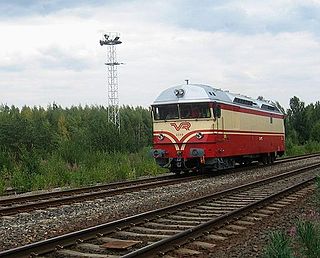
VR Class Dr13 was a heavy diesel locomotive used by VR Group. The Dr13 was designed by the French company Alstom. The class consisted of 54 locomotives, of which the first two were built by Alstom’s factory in Belfort, France and were shipped to Finland in 1962, while the rest were built in Tampere at the factories of Lokomo and Valmet. The first Dr13 series locomotive came to Finland on 24 October 1962. The Dr13 series was introduced between 1962 and 1963, and the last units were withdrawn by June 2000.
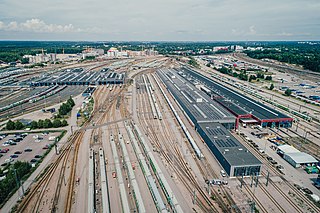
Ilmala depot is a railway depot owned and operated by the VR Group in Pohjois-Pasila, Helsinki. It is located to the west of the Posti distribution centre, south of Hakamäentie, east of Veturitie and north of the Postipuisto development area. The entire depot area is roughly 60 hectares in size, and it contains 65 km (40 mi) of rails. Roughly 800 people work in the area. The depot maintains the majority of VR's long-distance rolling stock and all of its commuter rail rolling stock.



